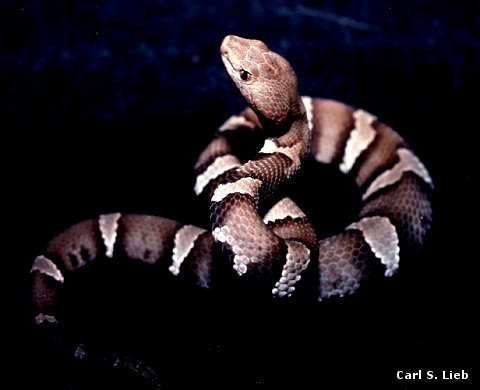
One of the more beautiful, though venomous, snakes of our Chihuahuan Desert is the Copperhead. Although predominately an eastern species, a geographically isolated subspecies occurs in the Big Bend region south into northernmost Mexico. The species is a member of the same family, the Viperidae, as the rattlesnakes. As with its relative, the Cottonmouth, there is no rattle. However, the Copperhead may vibrate its tail when agitated; among dry leaves, this gives a pretty good imitation of a rattle. Like other members of the Viperidae, a pair of pit organs lie between eyes and nostrils. Pit organs detect infra-red radiation and thus allow the animal to accurately locate warm-blooded prey in the dark. As with all snakes, it feeds strictly on animals.
Although its venom appears relatively less potent than in many
rattlesnakes, a bite should be taken seriously. Luckily, the animal is mild mannered,
and bites usually occur when the well-camouflaged snake is inadvertently touched. It
seemingly follows the old colonial motto, "Don't tread on me", and when
heeded, follows a live and let live philosophy. 
Contributor: Arthur H. Harris, Laboratory for Environmental Biology, Centennial Museum, University of Texas at El Paso.
Desert Diary is a joint production of the Centennial Museum and KTEP National Public Radio at the University of Texas at El Paso.

Copperhead (Agkistrodon contortrix). Photograph by Carl Lieb.
Copperhead: University of Michigan Museum of Zoology